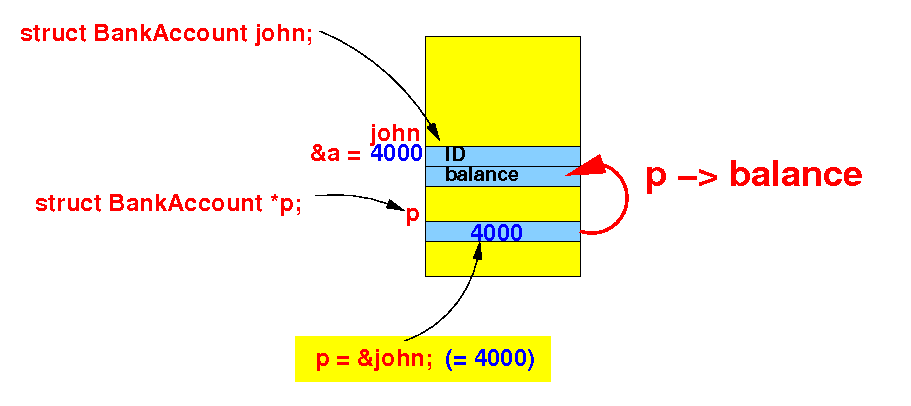Short-hand operators
|
The pointer-member-access operator
->
Previous, we have used (*p).fieldName with reference variables to access member variables in a struct:
#include <stdio.h>
struct BankAccount
{
int ID;
float balance;
};
int main( int argc, char *argv[] )
{
struct BankAccount john, mary, *p ;
john.balance = 500;
p = &john; // Now *p ≡ john
(*p).balance = (*p).balance + 2000;
mary.balance = 500;
p = &mary; // Now *p ≡ mary
(*p).balance = (*p).balance + 9000;
printf("j: %f m:%f\n\n", john.balance, mary.balance);
}
|
The pointer-member-access operator
->
The (binary) operator -> is a short hand operator for this combination of operations: (* ).
#include <stdio.h> // Operator -> is defined as: p->x ≡ (*p).x struct BankAccount { int ID; float balance; }; int main( int argc, char *argv[] ) { struct BankAccount john, mary, *p ; john.balance = 500; p = &john; // Now *p ≡ john (*p).balance = (*p).balance + 2000; mary.balance = 500; p = &mary; // Now *p ≡ mary (*p).balance = (*p).balance + 9000; printf("j: %f m:%f\n\n", john.balance, mary.balance); } |
The pointer-member-access operator
->
We can re-write this program using the -> operator as follows:
#include <stdio.h> // Program re-written using -> struct BankAccount { int ID; float balance; }; int main( int argc, char *argv[] ) { struct BankAccount john, mary, *p ; john.balance = 500; p = &john; // Now *p ≡ john p->balance = p->balance + 2000; mary.balance = 500; p = &mary; // Now *p ≡ mary p->balance = p->balance + 9000; printf("j: %f m:%f\n\n", john.balance, mary.balance); } |
Notice the
graphical similarity
|
